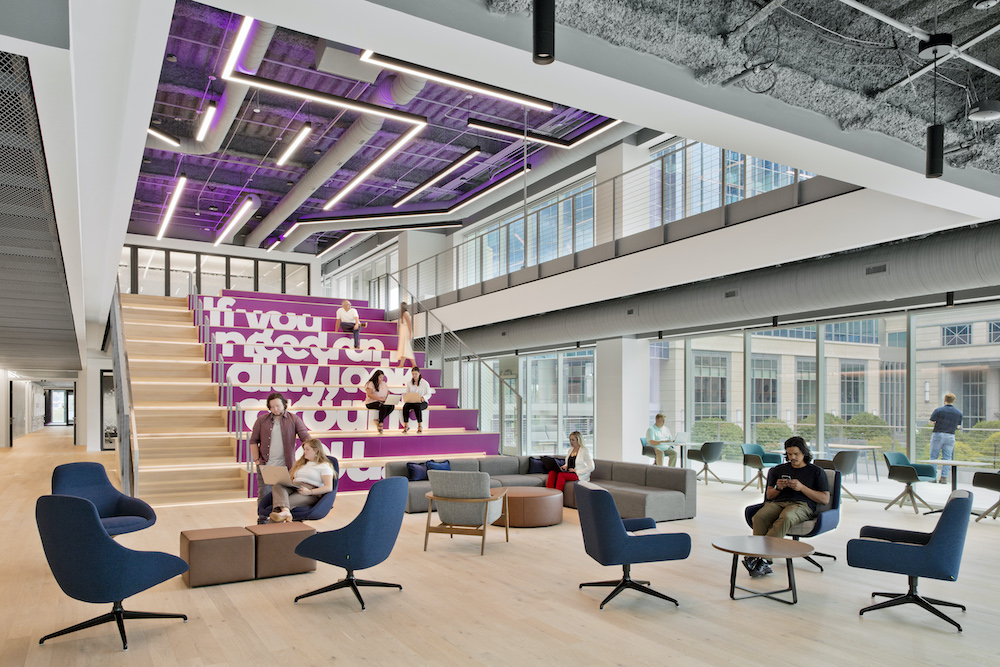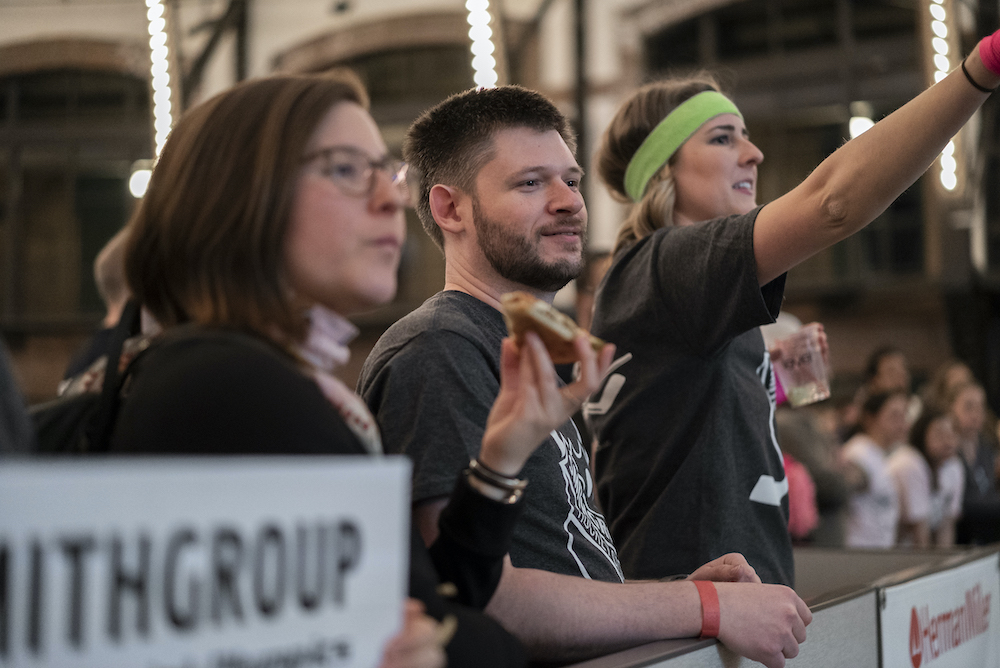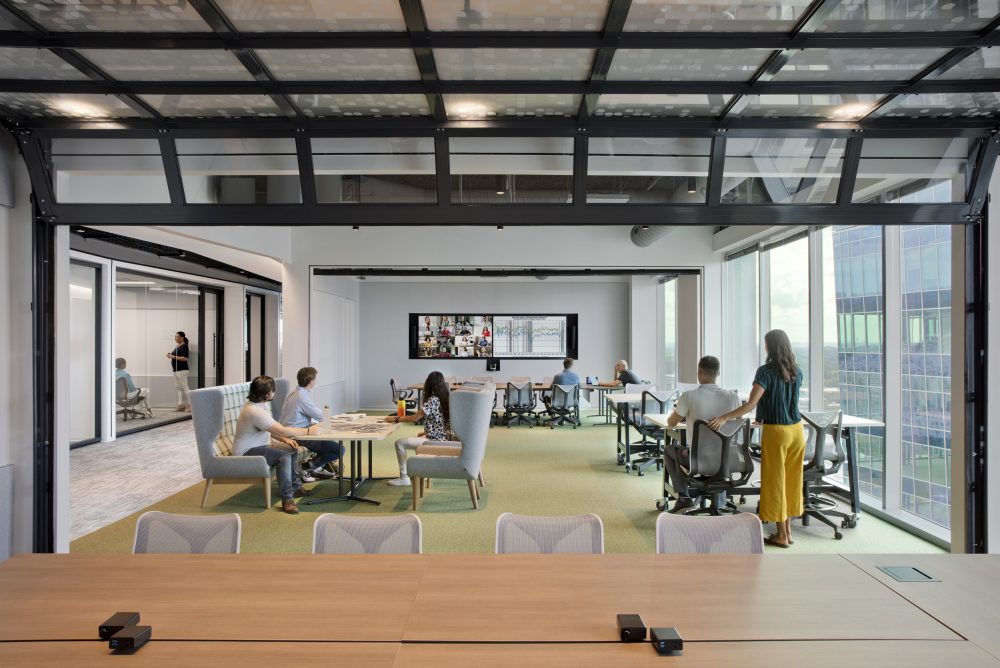Reinforcing Workplace Culture and Community In a Hybrid Future

In an article originally penned for Work Design Magazine, SmithGroup design and workplace strategy leaders Bob Varga and Alexis Kim explore the importance of stitching together office culture and community in order to thrive as we return to work.
As companies grapple with how to rebuild their once tried-and-true organizational communities – which sometimes feel like they’ve been unraveling in slow motion before our eyes – or take strides to maintain and build upon the organizational cultures that have evolved over the last two years, firm leaders must revisit their corporate values and assess if there’s a need to refine their company’s ethos.
Understanding the meaning of culture and community will help set the stage for appropriately responding and reacting to potential challenges. Merriam-Webster defines these terms as:
Culture: The set of shared attitudes, values, goals and practices that characterize an institution or organization.
Community: A body of persons of common and especially professional interests scattered through a larger society.
Reaffirming Values, Purpose, and Goals
The COVID-19 pandemic revealed some interesting dualities regarding what employees (and their employers) truly value. On one hand, a culture built around a sense of community will continue to include empathy for individuals and their challenges. With that in mind, how do organizations respond to the myriad of stressors that individuals continue to face?
Reaffirming and reinforcing a company’s shared values and goals defines an organization’s culture and clarifies the path that one needs to take to draw a corporate community together in the face of these challenges.
McKinsey notes that about 49-percent of women and 39-percent of men in dual career households identify as feeling burnt out.* Digging further into the reasons for suggested burn out reveals significant challenges that come from navigating competing daily work and life responsibilities. Adding the newest challenge – the requirement for employees to return to working in a physical office – is also causing concern as people cope with how to readjust routines and balance a variety of needs for the second time in a two-year span. “I come to the office to see people, as requested, but I often end up spending the entire day in a focus room on call after call. I am less productive because of the drive…So, why am I coming in again,” one frustrated senior partner at an engineering firm shared.
A culture built upon a sense of community will also likely include the shared values of growing, learning and mentoring staff.
On the other hand, a culture built upon a sense of community will also likely include the shared values of growing, learning and mentoring staff. So, how does an organization like this simultaneously consider how and why coming together should be valued? “I really like coming to the office…it makes me feel like I am integral to the work we do,” explained a Gen-Z employee who works at the same engineering firm. “I come to the office to learn. Even if it’s not directly related to projects that I am working on, I often find myself learning.” These are just a few examples that illustrate the varied feelings and considerations that employees across organizations are facing in the new world of work.
Framing the Circumstance
One key to success is recognizing that circumstances and concerns vary by age, gender, marital status, family circumstance, health conditions and more. Consequently, leaders are encouraged to not categorically assume patterns and make assumptions.
Let’s consider the following list of concerns that we’ve heard are currently weighing on the minds of employees and leaders:
- How will I deal with life situations that have evolved, or that were (temporarily) solved during COVID, when I’ve been asked to go back to working in the office? One automotive manufacturing employee shared, “I have a loved one with health challenges and am now the primary care giver for them. I must remain healthy, COVID-free and available to help when required.”
- Working parents who have devoted two years to developing new patterns to meet the demands of skillfully balancing parenting and career obligations are now also being challenged to create another new pattern, but with new parameters. One parent that works for a fintech company shared, “Our afterschool care provider changed its programming and hours of operation because they couldn’t get the staff they needed. As a result, they reduced the available spots for children and no longer have room for us. Now we are looking for a new solution at the same time we are supposed to be returning to in-office work.”
- Individuals, especially the newest in the workforce, are also starting to express that their professional development could be compromised by current circumstances. “I feel like my manager is focused on himself and that he forgets about me most of the time. I don’t have much to do and don’t know who to ask in a virtual environment when my manager is in back-to-back meetings day after day,” shared a new chemical engineer.
- Professional and social relationships are also challenged in virtual environments. Members of the workforce that are relocating to new cities are also struggling with loneliness and report feeling a lack of belonging. One father shared that his daughter, who recently relocated to take a new position with a technology company in Chicago, has been struggling with loneliness. “She was ecstatic to get a chance to go to the office for a single workshop, to meet some teammates and see if they could do something outside of work together.”

The Future is Already Here – Now What?
We stand on the precipice of a unique moment in time, when the possibility of looking forward becomes an opportunity for organizations to critically assess how employees are (or are not) being supported and consider how they might become more effective contributors within an organizational community.
Here’s what our workplace design experts and strategists have to offer. Take time to listen. People have opened themselves up and shared a wide range of needs over the last two years. Start with a good engagement process that allows you to “hear” from staff, then be prepared to respond with solutions that reveal empathy for their situations. Response to staff must also include thoughtfully crafted messages that help bridge and align a company’s values with the type of culture you want your organizational community to share. Authenticity is revealed when the messaging aligns with the actions a company takes.
In current work environments, many organizations are growing and evolving by incorporating staff that will always be fully remote. Therefore, it is essential to build belonging and community by making sure remote and virtual staff members can connect and participate in a variety of activities. Ensuring such participation will provide these teammates with a sense of security and will create opportunities for them to become emersed in a company’s culture. These attributes will reinforce a sense of security for individuals in times of uncertainty. They will also show teammates that they are valuable, important and relevant – as evidenced by the actions that their organizations take to ensure they can be present and participate in an array of virtual events.

It All Begins with People
If you are old enough to remember the 1980s sitcom, Cheers, what brought the characters together was not necessarily the place or the beer, but the sense of identity that this gathering spot represented: Where everybody knows your name. Recognizing the value of identity and belonging, leaders must also consider the importance of, and the impact that comes from connecting people with a company’s culture. Developing and executing activities, processes and approaches that bring together remote employees and those in-office as a community can go a long way toward fostering stability, loyalty and trust.
Though we are still early in navigating the new world of hybrid work, we must address a new, yet rising, concern: Far too often, companies have focused solely on bringing people together in person, which leaves out large segments of employees. Third spaces create unique opportunities for teams and individuals to engage and connect in pseudo-office settings if they feel comfortable doing so. Why not encourage smaller cohorts or team-level gatherings in a variety of spaces teams feel appropriate – including virtually? Companies may also consider providing fully virtual gathering opportunities to off-set in-person activities. Events might include hosting virtual cooking classes, escape room-style outings, and gaming or themed trivia nights. This approach will establish equity and reinforce a sense of value and belonging among remote and hybrid staff.
Connecting people – those who are new, tenured and already familiar with an organization – is also key to creating a sense of community and strengthening networks within an organization. Those who are responsible for organizing community- and culture-building activities are encouraged to be creative and utilize tools such as Donut, virtual chat sessions or speed-dating type events to encourage staff to meet new people within a company.
No matter the organization or industry, stitching culture and community together begins with people.
Opportunities for growth and mentorship should also include both in-person and virtual methods. Networking and mentoring events might include one-on-one coffee breaks (at real coffees shops or in virtual settings). Periodic gatherings or open work sessions for specific projects, teams or among cohorts could alternate between in-person and virtual portals. No matter the approach, offering a variety of opportunities to network at different scales and adopting a “leave no teammate behind” mindset is critical to the success of organizations moving forward. Additionally, companies should incorporate regular peer-to-peer recognition events and capitalize on opportunities to celebrate individual and collective accomplishments. These are just a few ideas that organizations can adopt to promote and strengthen camaraderie and culture.
No matter the organization or industry, stitching culture and community together begins with people. Let’s face it: At the end of the day, humans make up communities, and the culture within that community – that which represents the unique beliefs and practices of a group – resides within an individual. Building a meaningful and authentic culture and community in a hybrid world does not need to be complicated. However, it does require that organizations create opportunities with two aspects in mind: Scale – both micro and macro level; and method, both – in-person and virtual.

Positioned For Success
To tackle scale and method, companies can first identify and recognize cohorts and sub-communities by different interests, discipline groups and age groups. Next, the organization can empower these various groups to plan and execute activities. Entities should be sure to proactively share out “what’s happening” within these various micro-communities to start to connect broader organization. Such engagement will help create a greater community network and help staff remain engaged companywide. Companies should also organize larger activities focused on values and goals to further rally cohorts and promote camaraderie. Incorporating and sharing resources and best practice models for both in-person and virtual engagement for such activities ensures balance and equity, yet also allows companies to test how effective hybrid engagement can occur and gain valuable feedback. Ideally, between the companies structured approach and organic movement from employee side, sustainable work model starts to be defined.
The value that comes from having a healthy organizational culture and strong corporate community has always been an underlying current that has had profound impact on the overall performance and success of an organization. If we recognize one positive that has come from the COVID-19 pandemic it is that individuals have realized the value of life alongside work, not the other way around. A hybrid future is an opportunity for organizations to reframe and respond to that realization while strengthening the values that will matter most to employees. This experience has put spotlight on how companies can create stronger ties within their organizational communities and to assess their culture.
In the end, organizational culture is an ecosystem, not a tag line that companies can simply profess. To develop a true and meaningful organizational culture is to put forth values, beliefs and actions that resonate with staff. These values then become “shared” values supported through those actions. At that point, organizational goals also become individual goals, and employees become the ones propelling companies towards their future and growth.